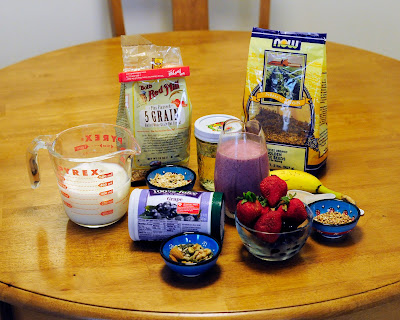Here are the 2 soup recipes from Nancy Smith.
|
Red Lentil Soup
3 tablespoons olive oil
1
large onion, chopped
2
garlic cloves, minced
1
tablespoon tomato paste
1
teaspoon ground cumin
1/4
teaspoon kosher salt, more to taste
1/4
teaspoon ground black pepper
Pinch
of ground chili powder or cayenne, more to taste
1
quart chicken/vegetable broth
1
cup red lentils
1
large carrot, peeled and diced
|
Preparation:
1.
In large pot, heat oil -add onion, garlic and sauté until golden, about 4
minutes.
2.
Stir in tomato paste, cumin, salt, black pepper and chili powder or cayenne,
and sauté for 2 minutes.
3.
Add broth, 2 cups water, lentils and carrot. Bring to simmer, then
partially cover pot and turn heat to medium-low. Simmer until lentils are
soft, about 30 minutes. Taste and add salt if necessary.
4.
Using an immersion or regular blender, puree half the soup then add it back
to pot.
5.
Thicken with cornstarch if you like a thicker soup.
|
Lentil Soup
2
tablespoons olive oil
1
cup finely chopped onion
1/2
cup finely chopped carrot
1/2
cup finely chopped celery
2
teaspoons kosher salt
1
pound lentils, picked and rinsed
1
cup peeled and chopped tomatoes
2
quarts chicken or vegetable broth
1/2
teaspoon freshly ground coriander
1/2
teaspoon freshly ground toasted cumin
1/2
teaspoon freshly ground grains of paradise
|
Preparation:
1.
Place oil in large 6 quart pan over medium heat.
2.
Add onion, carrot, celery and salt and cook until onions are translucent,
about 6-7 minutes.
3.
Add lentils, tomatoes, broth, coriander, cumin and grains of paradise and
stir to combine.
4.
Increase heat to high and bring just to a boil. Reduce the heat to low, cover
and cook at a low simmer until the lentils are tender, about 35-40 minutes.
5.
Using a stick blender, puree to your preferred consistency.
6.
If you don't have grains of paradise, use some cardamom.
|
Popped Pumpkin Seeds brought by Angela Gonzales
Sesame seed
oil for high heat
3 cups
pumpkin seeds
1 red onion,
chopped fine
1 clove
garlic
Salt and
pepper
Heat oil in
a low wide pan with glass lid on. When
oil is hot toss in pumpkin seeds and replace lid.
Let seeds
pop.
Add onion
salt and pepper.
Stir.
When seeds
turn golden yellow squeeze in garlic.
Serve.
Blueberry Cream Flax
Muffins
Ingredients:
2 cups flour 1
T flax seed ½
cup vegetable oil
1 cup sugar 1
cup fresh blueberries !/2
t. vanilla extract
½ t. baking powder ¼
cup sour cream
½ t. baking soda 1/3
c. milk
½ t. salt 2
eggs
Directions:
1.
Preheat oven to 400 degrees F. grease 12 paper
or foil muffin cups and insert them in a muffin pan.
2.
In a large bowl, mix together all the dry
ingredients. Add blueberries last and
gently stir.
3.
Combine wet ingredients in a separate bowl, whisk
and carefully mix the wet ingredients into the dry ingredients. Stir the batter
just until it’s evenly moistened.
4.
Fill muffin cups until they are about ¾ full and
bake for 20-22 minutes. Serve warm!
Flax and Chia Healthy Snack
2 cups oats 1 cup peanut butter
1 cup ground flax seed 1/2 cup honey
2 T. chia seeds 2 tsp vanilla
1 cup chocolate chips
Mix together and roll in balls or put in a 9 x 13 pan and flatten.
Keep in the refrigerator or can freeze.
Flaxseed Spread (from Dr. Nedley's text)
1/4 c ground flaxseed
1/4 c finely chopped walnuts
1 T. date sugar
1/8 t. salt
Mix and serve with apples or over toast--whatever way you find it tasty.
Flax and Chia Healthy Snack
2 cups oats 1 cup peanut butter
1 cup ground flax seed 1/2 cup honey
2 T. chia seeds 2 tsp vanilla
1 cup chocolate chips
Mix together and roll in balls or put in a 9 x 13 pan and flatten.
Keep in the refrigerator or can freeze.
Flaxseed Spread (from Dr. Nedley's text)
1/4 c ground flaxseed
1/4 c finely chopped walnuts
1 T. date sugar
1/8 t. salt
Mix and serve with apples or over toast--whatever way you find it tasty.





















